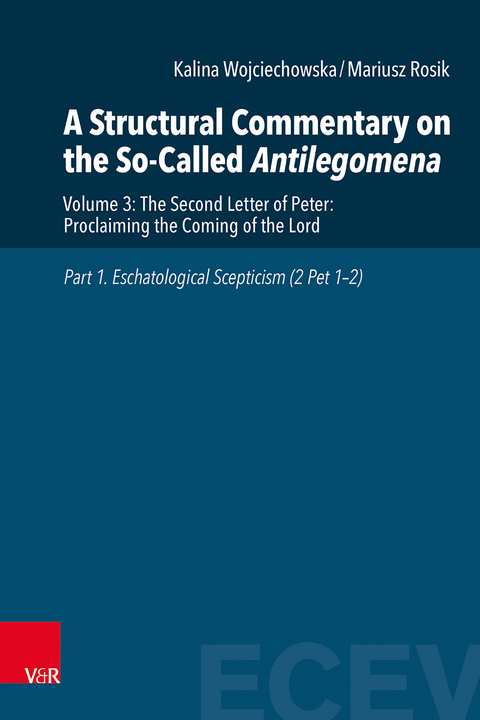A Structural Commentary on the So-Called Antilegomena
Volume 3: The Second Letter of Peter: Proclaiming the Coming of the Lord. Part 1. Eschatological Scepticism (2 Pet 1–2)
Seiten
2024
|
1. Edition
Vandenhoeck & Ruprecht (Verlag)
978-3-525-50366-9 (ISBN)
Vandenhoeck & Ruprecht (Verlag)
978-3-525-50366-9 (ISBN)
Peter as a critic of eschatological scepticism and proponent of eschatological hermeneutics
The structural approach facilitates exposure of the elements of eschatological teaching characteristic of 2 Peter's author with its correct or incorrect interpretation. Narratives drawn from Jewish tradition aim to show two attitudes towards the announcement of destruction: a positive attitude, signifying salvation, and a negative attitude, signifying annihilation. This pattern is transferred to the attitude towards prophetic and apostolic eschatological teaching. Part 1 of the commentary (2 Pet 1-2) focuses on the misinterpretation of this teaching by false teachers and their followers. Their eschatological scepticism is ridiculed and their grim fate described. As the starting point for this description and Peter's whole line of argumentation 2 Pet 2:3b is taken - the thesis is that God's inaction is only apparent, while judgment and punishment are inevitable, although only God knows when they will be executed.Part 2 of the commentary (2 Pet 3) focuses on the proper interpretation of this teaching and on laying out the principles of the letter author's hermeneutics. This hermeneutic construes texts from Jewish tradition as foreshadowing and typologies of eschatological events. In explaining the principles of his hermeneutic, the letter's author drew on the creation story, which Jewish apocalypticism read inversely, to mark that the eschatological hermeneutics is rooted in tradition. The starting point of Peter's line of argumentation was taken to be 2 Pet 3:5.7 with its thesis of God's creative and destructive word and God's sovereign will regarding the preservation of creation and the appointment of the time of judgement. This thesis explains the apparent lack of divine action, which was also a major concern in Part 1 of the commentary (2 Pet 1-2).
The structural approach facilitates exposure of the elements of eschatological teaching characteristic of 2 Peter's author with its correct or incorrect interpretation. Narratives drawn from Jewish tradition aim to show two attitudes towards the announcement of destruction: a positive attitude, signifying salvation, and a negative attitude, signifying annihilation. This pattern is transferred to the attitude towards prophetic and apostolic eschatological teaching. Part 1 of the commentary (2 Pet 1-2) focuses on the misinterpretation of this teaching by false teachers and their followers. Their eschatological scepticism is ridiculed and their grim fate described. As the starting point for this description and Peter's whole line of argumentation 2 Pet 2:3b is taken - the thesis is that God's inaction is only apparent, while judgment and punishment are inevitable, although only God knows when they will be executed.Part 2 of the commentary (2 Pet 3) focuses on the proper interpretation of this teaching and on laying out the principles of the letter author's hermeneutics. This hermeneutic construes texts from Jewish tradition as foreshadowing and typologies of eschatological events. In explaining the principles of his hermeneutic, the letter's author drew on the creation story, which Jewish apocalypticism read inversely, to mark that the eschatological hermeneutics is rooted in tradition. The starting point of Peter's line of argumentation was taken to be 2 Pet 3:5.7 with its thesis of God's creative and destructive word and God's sovereign will regarding the preservation of creation and the appointment of the time of judgement. This thesis explains the apparent lack of divine action, which was also a major concern in Part 1 of the commentary (2 Pet 1-2).
Kalina Wojciechowska, Dr Hab., is Professor in the Department of New Testament Studies and Greek Language of the Christian Theological Academy in Warsaw.
Mariusz Rosik is Professor for New Testament Exegesis, Biblical Environment and Jewish History at the Pontifical Faculty of Theology in Wrocław, Poland.
Rajmund Pietkiewicz is Professor and Vice-President of the Pontifical Faculty of Theology in Wrocław.
Krzysztof Pilarczyk, Prof. Dr. Hab., was Professor of Judaic and Biblical Sciences and Religious History and Head of the Laboratory of the History of Christian-Jewish Relations at the Institute of Religious Studies of the Jagiellonian University in Krakow.
| Erscheinungsdatum | 14.06.2024 |
|---|---|
| Reihe/Serie | Eastern and Central European Voices ; Volume 3.3, Part 1 |
| Mitarbeit |
Herausgeber (Serie): Rajmund Pietkiewicz, Krzysztof Pilarczyk |
| Verlagsort | Göttingen |
| Sprache | englisch |
| Maße | 160 x 235 mm |
| Gewicht | 978 g |
| Themenwelt | Religion / Theologie ► Christentum ► Bibelausgaben / Bibelkommentare |
| Schlagworte | Antilegomena • Brief des Judas • Neues Testament |
| ISBN-10 | 3-525-50366-0 / 3525503660 |
| ISBN-13 | 978-3-525-50366-9 / 9783525503669 |
| Zustand | Neuware |
| Haben Sie eine Frage zum Produkt? |
Mehr entdecken
aus dem Bereich
aus dem Bereich
Buch | Softcover (2021)
De Gruyter (Verlag)
CHF 45,90
wie wir uns unsere spirituelle Heimat zurückholen
Buch | Hardcover (2024)
Patmos Verlag
CHF 27,95




